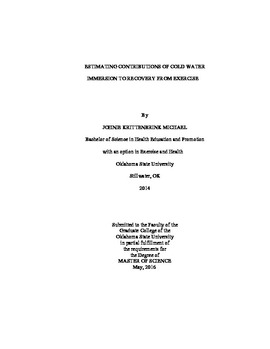| dc.description.abstract | Investigate the efficacy of cold water immersion (CWI) for alleviating perceived soreness and to estimate its contributions to muscle damage recovery after exercise. METHODS: Fourteen (mean age=22.4 years, height= 1.81m, mass=88.38kg) males with history of resistance training (defined by at participation in 3 resistance training sessions a week) visited the lab on 2 occasions, separated by 7 days. First visit involved familiarization protocol with the Biodex 3 dynamometer. Participants performed isometric maximal voluntary contractions (MVCs) at a fixed joint angle of 120� to determine peak torque of the knee extensors before the exercise protocol (PRE), immediate post-exercise protocol (IPP), immediate post-treatment (IPT), and fifteen minutes post-treatment (15minPost, treatment visit only). The eccentric exercise protocol (10 repetitions/set at 60�/s) designed to induce muscle damage was performed on right leg only during treatment and control visit (randomized visits). Control involved sitting quietly in a chair in the research laboratory for 10 minutes. The treatment condition involved CWI up to the iliac crest in 10�C (50�F) water for 5 minutes. Perceived soreness was measured using 100-point analog scale. Soreness was measured during both visits at 5 time points (PRE, IPP, IPT, 24HrPost, 48HrPost). Separate 2-way mixed factorial ANOVAs were performed for each dependent variable. An alpha level of p?0.05 was utilized to determine statistical significance. RESULTS: Significant visit x time interaction found for exercise leg MVC torque [F(2,26)=3.463, p=0.046]. MVC torque IPT treatment significantly lower than PRE treatment [p=0.045]. Significant effect for time found for MVC during treatment visit exercise leg [F(2,26)=4.471, p=0.021]. Significant interaction found between condition and time for exercise leg treatment visit MVC [F(2,26)= 3.463, p=0.046]. There was no significant visit x time interaction for control leg MVC [F(2,26)=1.086, p=0.352]. No significant main effect for time of control leg MVC [F(2,26)= 0.871, p=0.430]. A significant main effect for condition was found for control leg MVC [F(1,13)=6.401, p=0.025]. Significant difference found between control and treatment visit perceived soreness at 24HrPost for exercise leg [p=0.028]. CONCLUSIONS: CWI did not have an effect on peak torque production, but significantly reduced perceived soreness 24HrPost treatment on the exercise leg compared to control visit. | |
